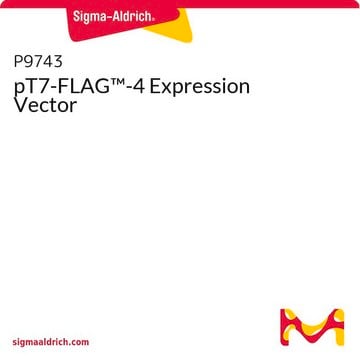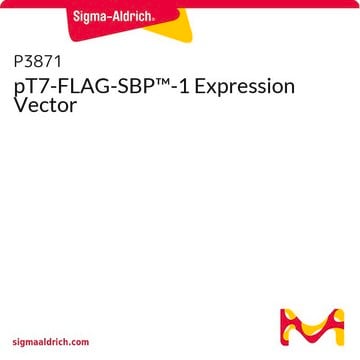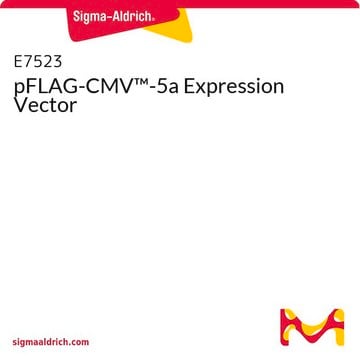P1118
pT7-FLAG™-1 Expression Vector
Se connecterpour consulter vos tarifs contractuels et ceux de votre entreprise/organisme
About This Item
Code UNSPSC :
12352200
Produits recommandés
Qualité
for molecular biology
Forme
buffered aqueous solution
Conditions d'expédition
dry ice
Température de stockage
−20°C
Description générale
pT7-FLAG™-2 is a 4.8 kb E . coli expression vector used for cloning and cytoplasmic expression of a properly inserted open reading frame as a N-terminal Met-FLAG fusion protein containing the FLAG® epitope (DYKDDDDK). The promoter region of the very strong phage T7 promoter drives transcription of ORFFLAG fusion constructs. This vector requires the use of E. coli cells containing a source of the T7 polymerase, such as BL21(DE3)T1R cells, Catalog Number B2935.
Application
pT7-FLAG®-1 Expression Vector has been used in the cloning of ubiquitin fusion protein and connexin 43 (Cx43) C-terminal fragment.
Composants
pT7-FLAG™-1 Expression Vector (P6742) is supplied as 0.5 mg/ml in 10 mM Tris-HCl (pH 8.0) with 1 mM EDTA.
pT7-FLAG™-1-BAP Control Vector (P6992) is supplied as 0.5 mg/ml in 10 mM Tris-HCl (pH 8.0) with 1 mM EDTA.
pT7-FLAG™-1-BAP Control Vector (P6992) is supplied as 0.5 mg/ml in 10 mM Tris-HCl (pH 8.0) with 1 mM EDTA.
Informations légales
FLAG is a registered trademark of Merck KGaA, Darmstadt, Germany
pT7-FLAG is a trademark of Sigma-Aldrich Co. LLC
Produit(s) apparenté(s)
Code de la classe de stockage
12 - Non Combustible Liquids
Faites votre choix parmi les versions les plus récentes :
Certificats d'analyse (COA)
Lot/Batch Number
Vous ne trouvez pas la bonne version ?
Si vous avez besoin d'une version particulière, vous pouvez rechercher un certificat spécifique par le numéro de lot.
Déjà en possession de ce produit ?
Retrouvez la documentation relative aux produits que vous avez récemment achetés dans la Bibliothèque de documents.
Chase T Archer et al.
The Journal of biological chemistry, 283(31), 21789-21798 (2008-06-03)
Destabilization of activator-DNA complexes by the proteasomal ATPases can inhibit transcription by limiting activator interaction with DNA. Modification of the activator by monoubiquitylation protects the activator from this destabilization activity. In this study, we probe the mechanism of this protective
Alasdair I Macdonald et al.
The Biochemical journal, 446(1), 9-21 (2012-06-05)
Gap junctions, composed of Cxs (connexins), allow direct intercellular communication. Gap junctions are often lost during the development of malignancy, although the processes behind this are not fully understood. Cx43 is a widely expressed Cx with a long cytoplasmic C-terminal
Yo Sugawara et al.
The Journal of cell biology, 189(4), 691-700 (2010-05-12)
Botulinum neurotoxin is produced by Clostridium botulinum and forms large protein complexes through associations with nontoxic components. We recently found that hemagglutinin (HA), one of the nontoxic components, disrupts the intercellular epithelial barrier; however, the mechanism underlying this phenomenon is
Ning Kong et al.
Autophagy, 16(10), 1737-1752 (2019-12-24)
Interferon-induced BST2 (bone marrow stromal cell antigen 2) inhibits viral replication by tethering enveloped virions to the cell surface to restrict viral release and by inducing the NFKB-dependent antiviral immune response. However, the mechanism by which BST2 uses the selective
Notre équipe de scientifiques dispose d'une expérience dans tous les secteurs de la recherche, notamment en sciences de la vie, science des matériaux, synthèse chimique, chromatographie, analyse et dans de nombreux autres domaines..
Contacter notre Service technique






